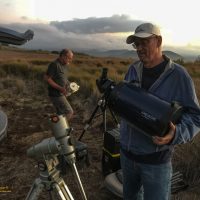A few months back I was reminded that I was remiss in scheduling proper club star parties. Thus I set about fixing that!

Thus I compromised at using my favorite site at Kaʻohe. At 5,800ft the site is lower, warmer, and less windy than the VIS. It also represents about half the drive time it takes to get to the VIS, without the tourist crowd. The site is higher and offers more reliable skies than the Puʻu Kuainiho site
The site is DLNR land, so a permit is required for a group. At this point the lady at the Waimea DOFAW office does not even ask what or why, she just asks me what date to make the permit out for.
At our last event in late November about six vehicles showed up at Ka’ohe, this time is we doubled that, about a dozen vehicles and telescopes with about twenty folks. This is the largest crowd yet, and about the limit in size I would like to see. All of the usual nefarious suspects were there… Chris, Cliff, Tony, Scott, along with a few astronomy community visitors from off island.

The Kaʻohe site provided exactly as I have come to expect. Cloudy just before sunset, clearing quickly in time for a gorgeous sunset. A bit damp with dew just after dark, drying out as the night progressed. A slight breeze for a few hours with some calm on to morning. Above was a beautiful dark night sky awash with stars!
This latest series of star parties is the first time I have been able to convince other folks in the club to try the site after years of mentioning it. The response has been basically “why did you not tell us before!” Yeah, I did.
Between socializing at various telescopes I did get in some serious observing, working my way through my lifetime observing list. I had intended to do some work using the Bedford Cycle, but was stymied by the cross referencing to modern object designations. Need to work out a better way to do that.

FR Cas Quite faint, dimmer than the 9.6 average listed for this carbon star, quite red
King 14 A notable clump of stars in a bright Milky Way starfield, good sized at 10′ across, bright, coarse, resolved, in the same field as NGC133 and NGC146
GK Ori A nice ruddy orange carbon star, dim, in a very rich Milky Way starfield
Berkeley 62 Visually a poor object, about half a dozen 10th magnitude stars in a 5′ area
There was more to the show. Off to the south the military was busy playing games over Pōhakuloa. Fortunately not artillery flares with the bright yellow light illuminating the landscape. Rather it was helicopter gunships shooting rockets and cannon. You could see the white streaks of the rockets or the red flickers of the tracer rounds. Followed seconds later by the thud and rattle of the explosions and gunfire.
I pulled out about 3am with Jupiter and Mars rising over the mauna. Four pages of notes in my observing notebook testifying to a very nice night in the dark.



How do you control white lights and car headlamps? Do you exclude tourists or require “education” to visit or enter?
We had some issue with that, one late arrival with headlights trying to find the site. Some light as folks left earlier than others. We just dealt with it as we could. The late arrival I guided to an easy spot to setup by the road without pulling through the rest of the telescopes. Most folks pulled out slowly on parking lights.
Nice report!